Brinjal sambar is a quick and delicious South Indian sambar variant made with small brinjals (known as baingan in Hindi and kathirikai in the Tamil Language). It includes the usual sambar ingredients like tuvar dal (pigeon pea lentils), onions, tomatoes, tamarind, sambar powder, herbs and spices. Instead of adding various mixed vegetables, this kathirikai sambar is made with brinjal as the star ingredient. If you like brinjals I am sure you will enjoy this sambar variation with full flavors of the brinjal. A vegan recipe.
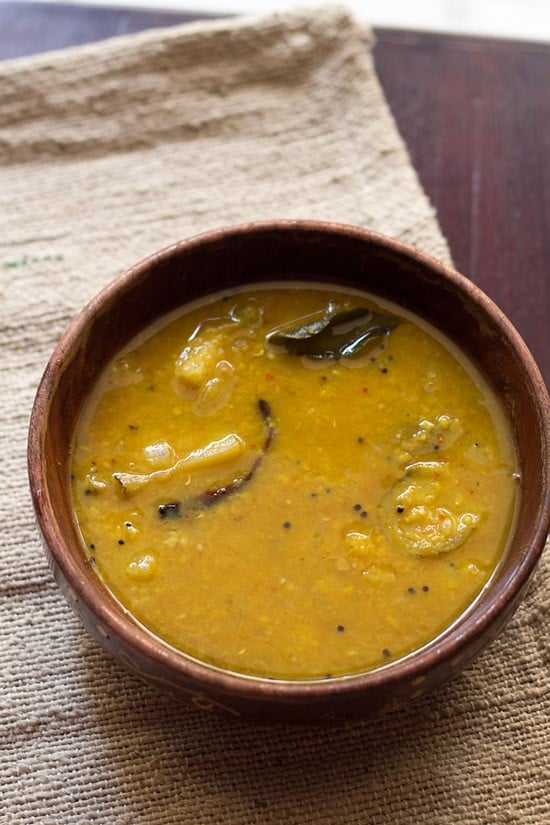
I make Sambar and Rasam very often along with vegetable side dishes. As they are easy to make, tasty and healthy also. Thus I have shared many sambar and rasam varieties on the blog.
Apart from the Drumstick Sambar and Varutharacha Sambar that I make, this is my go-to recipe for making sambar with any veggies, be it aubergines, okra, radish, spinach or even mixed veggies.
In this kathirikai sambar, I have used homemade Sambar Powder. Now when using sambar powder, always make your own if you can or buy a good quality sambar powder.
I personally prefer to make my own sambar powder as you know that homemade spice mixes are the best. You know what ingredients you are adding to it and it is packed with full of flavors and anytime better than store-bought ones.
For this brinjal sambar I have used the tiny brinjals with thorns on them. They are also called as gavti brinjal. These country brinjals or native brinjal variety are green in color with thorns on the stems and are generally used for making Bharli Vangi (stuffed brinjals). However, any brinjal or aubergine would be good in the sambar.
I have used the pressure cooker for cooking the dal and then cooking the brinjals too. However, you can also use a pot for cooking the dal and the brinjals. This is a quick recipe of making sambar… And one I often resort to when I have less time.
It makes for a comforting meal when paired with steamed rice, rasam, poriyal by the side. Finish the meal with some Curd Rice and you have a satisfying lunch.
How to make Brinjal Sambar
1. Soak 1.5 to 2 tablespoons of seedless tamarind in ½ cup water for 20 to 25 minutes.
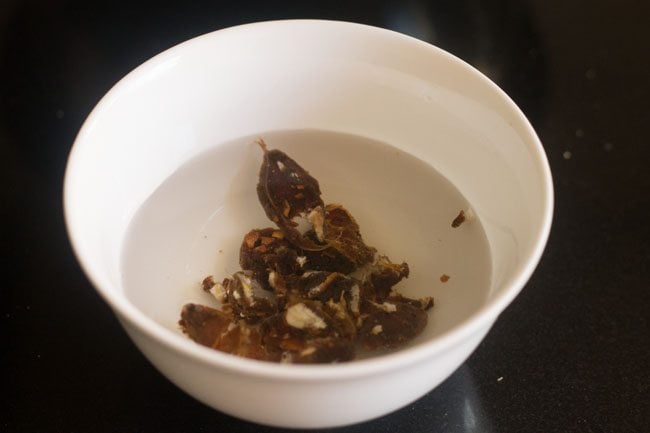
2. Squeeze and extract the pulp from the tamarind. Keep the tamarind pulp aside.
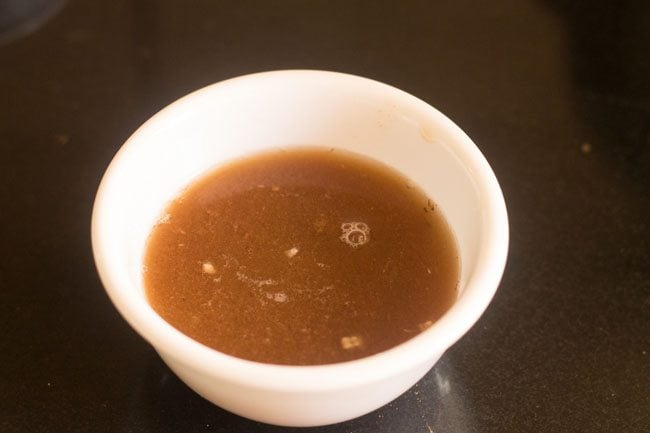
3. Add 1 cup tuvar dal (pigeon pea lentils or arhar dal) with 1 medium-sized quartered onion and 2 pinches of asafoetida powder (hing) with 2.5 to 3 cups water in a pressure cooker.
You can also cook the lentils in a pan or Instant pot adding water as required.
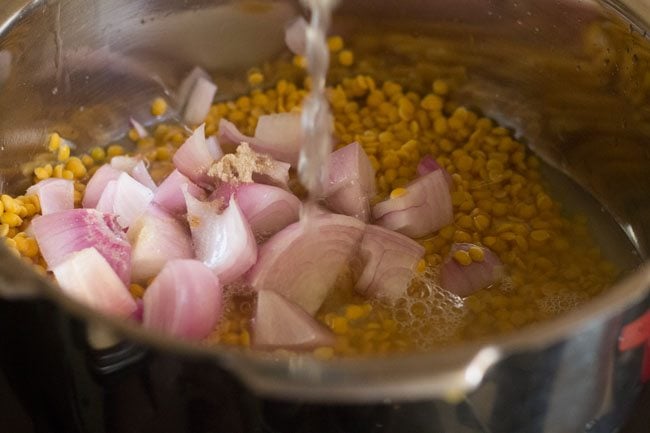
4. Pressure cook the lentils for 8 to 10 minutes on medium to medium-high heat or until they have softened and cooked completely.
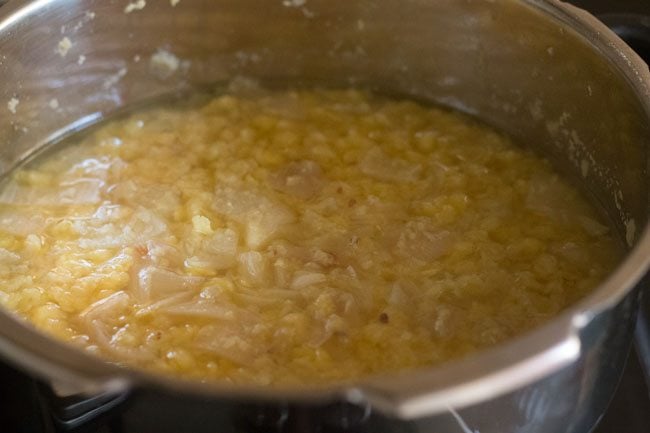
5. Quarter or chop 250 to 300 grams brinjals. Soak them in salted water for 15 to 20 minutes. Soaking them in salted water removes the bitterness if any from them.
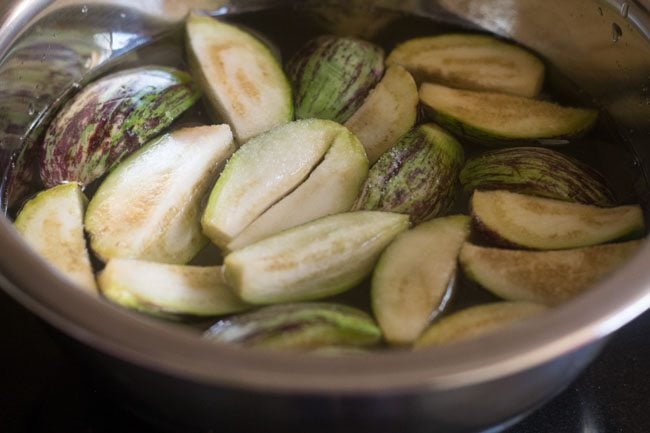
6. Once the pressure settles down on its own in the cooker, then only open the cooker lid and mash the lentils with a wired whisk or spoon.
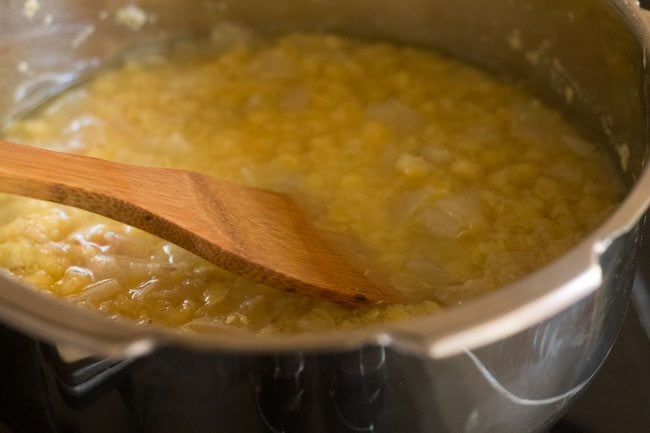
7. Now add 2 to 2.5 cups of water or as required. Drain all the water from the chopped brinjals and add them to the cooker.
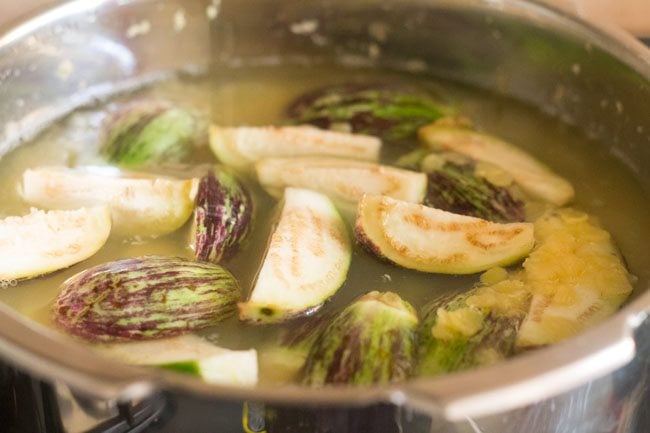
8. Also add 1 medium to large-sized quartered tomato.
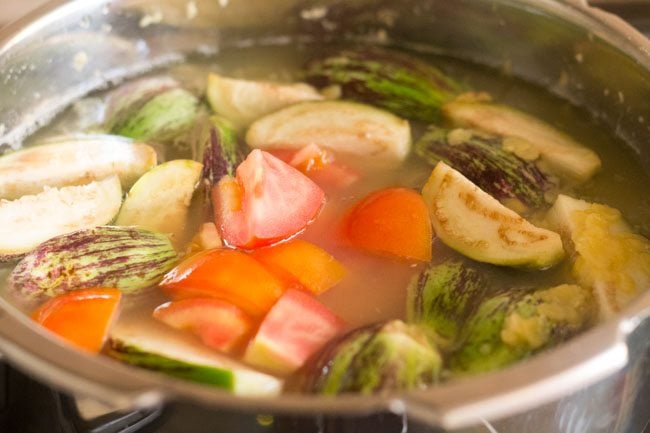
9. Add salt as required, 1 teaspoon red chili powder and ½ teaspoon turmeric powder to the dal.
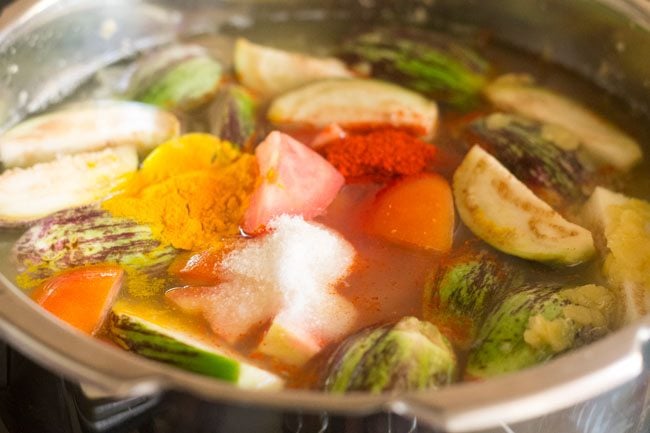
10. Stir and pressure cook again for 1 whistle on medium to medium-high heat. Let the pressure settle down on its own again and then only open the cooker lid. The brinjals would be tender and cooked by now.
If you prefer you can either lightly saute the brinjal and tomatoes separately in some oil or cook them in some water in a pan. Then add them to the mashed lentils.
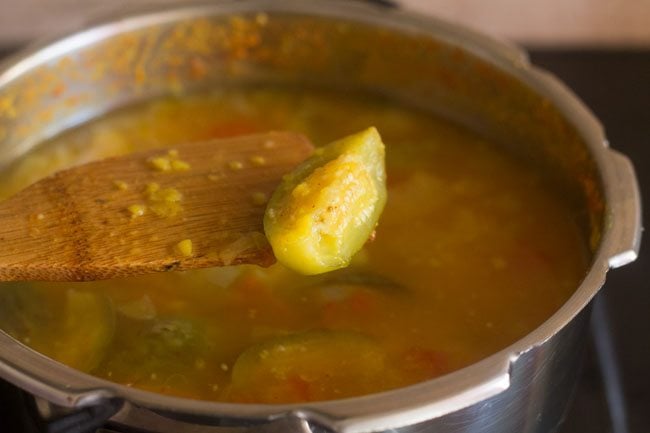
11. Now add 2 to 3 tablespoons of sambar powder and the prepared tamarind pulp. Add the sambar powder depending on its fragrance and quality.
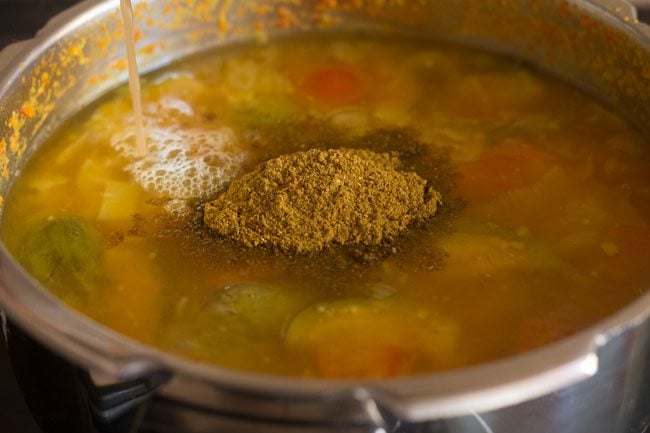
12. Simmer for 5 to 6 minutes on low to medium-low heat or till the rawness of the tamarind goes away and the whole mixture has well-blended flavors and taste. Stir often so that the lentils do not stick at the bottom of the cooker.
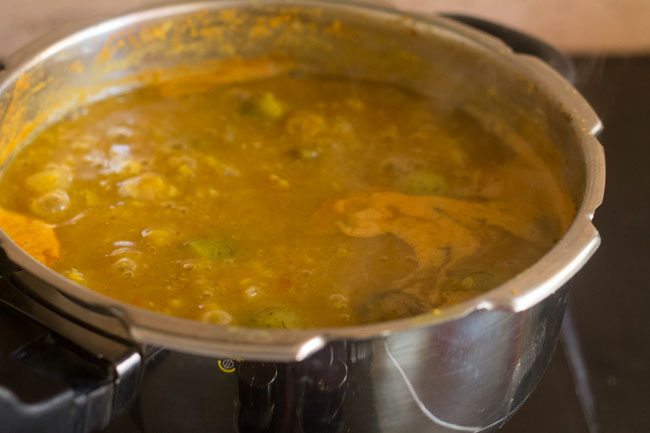
Making tempering for brinjal sambar
13. Measure and keep all the ingredients ready for tempering.
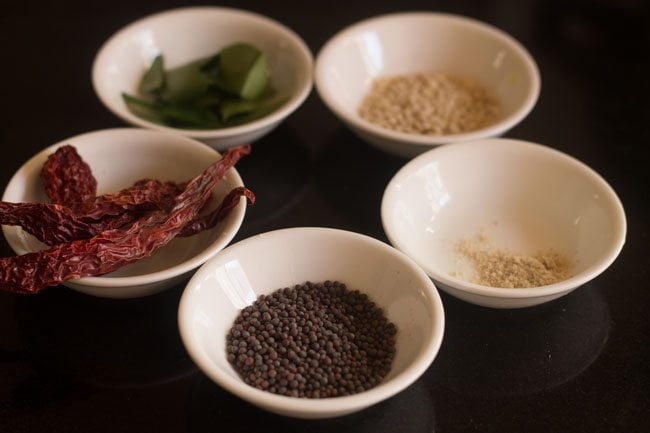
14. In a small pan, heat 3 to 4 tablespoons of oil. Add 1 teaspoon black mustard seeds and 1 teaspoon urad dal (split and skinned black gram).
You can use sesame oil (gingelly oil) or coconut oil or any neutral flavored oil.
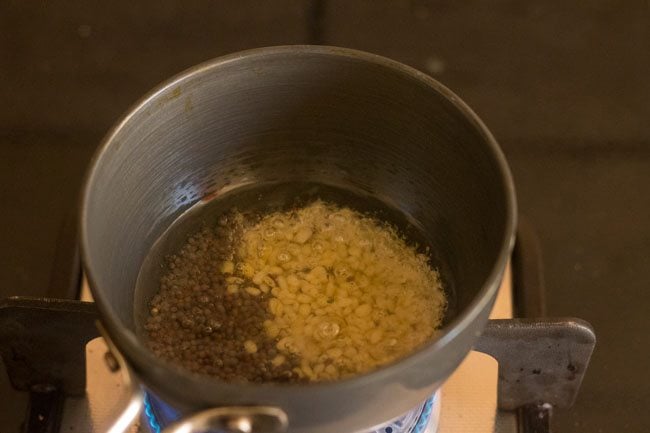
15. Keep stirring and let the mustard seeds splutter and the urad dal turn golden.
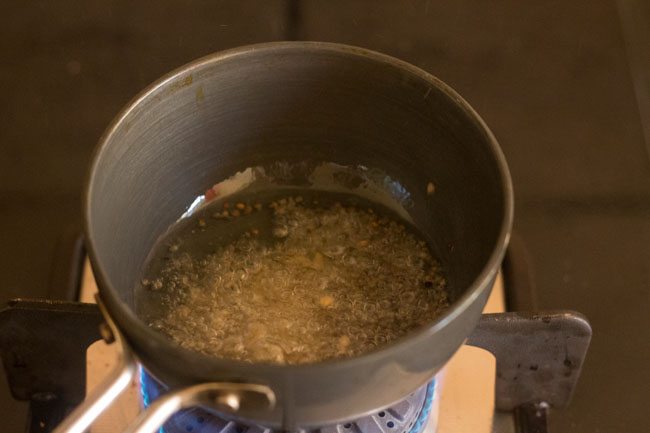
16. Add 3 to 4 dry red chilies, 15 to 20 curry leaves and 1 pinch of asafoetida (hing).
You can remove the seeds from the red chilies if you want. Also note that when adding curry leaves the oil will splutter, so be careful.
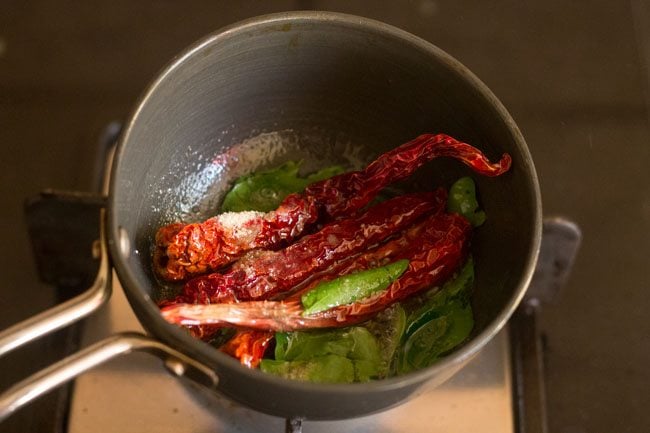
17. Fry for some seconds till the red chilies change color and curry leaves become crisp.
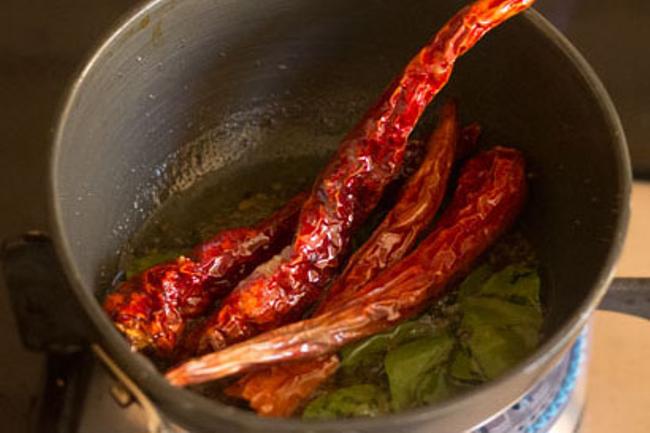
18. Stir and immediately pour the tempering mixture on the sambar.
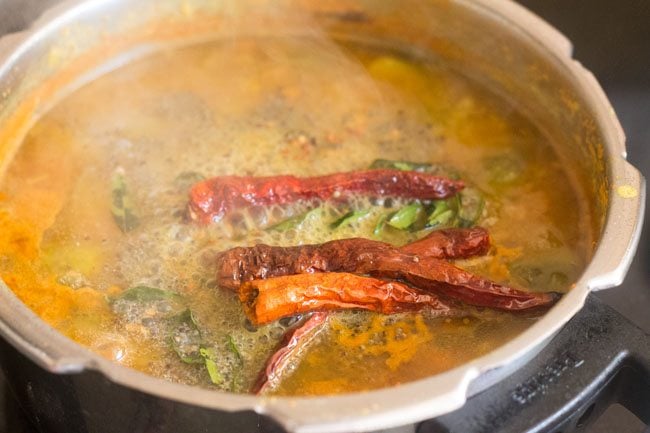
19. Cover with a lid, so that the flavors get absorbed.
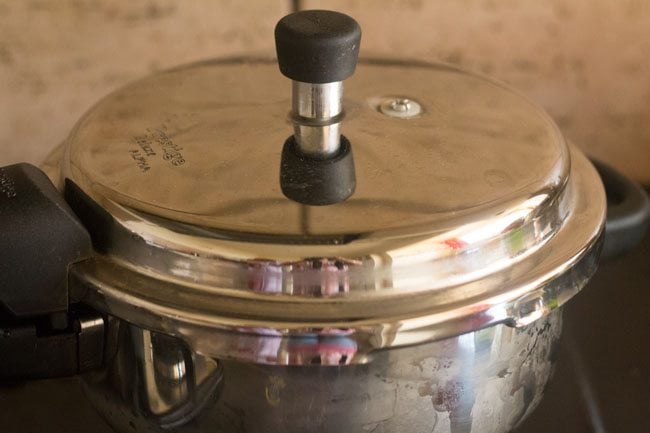
20. Open the lid after 4 to 5 minutes.
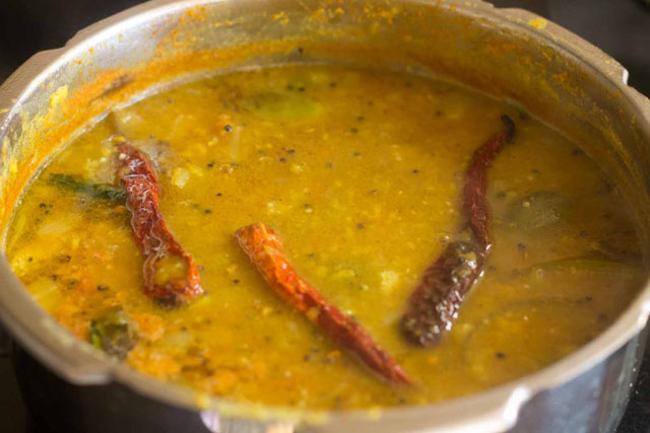
21. Garnishing with coriander leaves is optional. Serve the brinjal sambar hot with steamed rice. You can also have it with Idli or Dosa or Medu Vada.
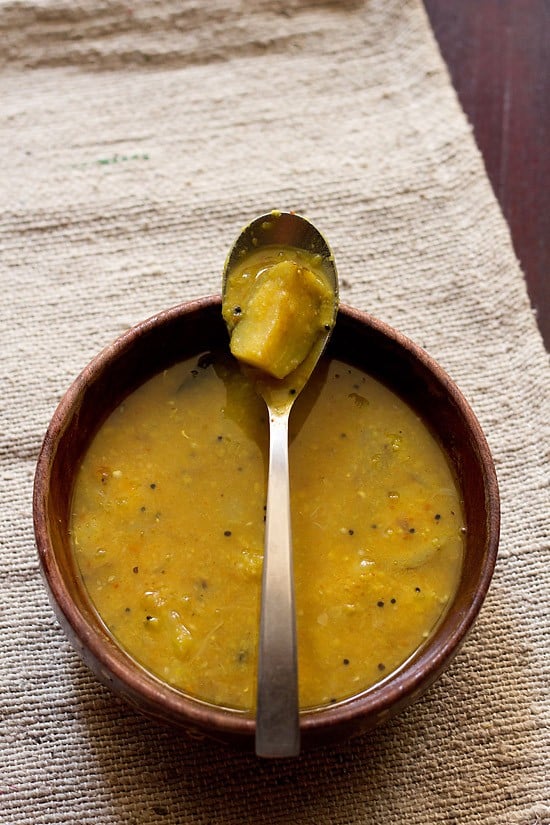
Few more Sambar varieties
Please be sure to rate the recipe in the recipe card or leave a comment below if you have made it. For more vegetarian inspirations, Sign Up for my emails or follow me on Instagram, Youtube, Facebook, Pinterest or Twitter.
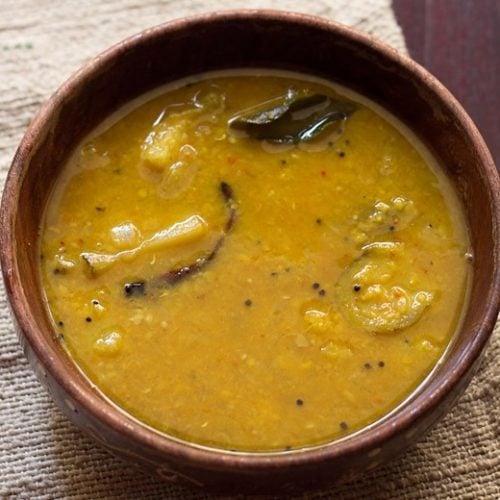
Brinjal Sambar (Kathirikai Sambar)
Ingredients
For Tamarind Pulp
- 1.5 to 2 tablespoons seedless tamarind
- ½ cup water
For Pressure Cooking Lentils
- 1 cup pigeon pea lentils (tuvar dal or arhar dal)
- 1 onion – quartered or sliced (medium sized)
- 2 pinches asafoetida (hing)
- 2.5 to 3 cups water for pressure cooking lentils
Other Ingredients for brinjal sambar
- 250 to 300 grams brinjals (kathirikai or eggplant)
- 2 or 2.5 cups water to be added later
- 1 tomato – quartered (medium to large-sized)
- salt as required
- 1 teaspoon red chili powder
- ½ teaspoon turmeric powder (ground turmeric)
- 2 to 3 tablespoons Sambar Powder or as required
For tempering
- 3 to 4 tablespoons oil sesame oil (gingelly oil) or coconut oil or any neutral flavored oil
- 1 teaspoon black mustard seeds
- 1 teaspoon spilt and skinned black gram (urad dal)
- 3 to 4 dry red chilies
- 15 to 20 curry leaves
- 1 pinch asafoetida (hing)
Instructions
Making brinjal sambar
- Soak the tamarind in water for 20 to 25 minutes.
- Squeeze and extract the pulp from the tamarind. Keep the tamarind pulp aside.
- Boil the tuvar dal with onions and asafoetida powder with 2.5 to 3 cups water in a pressure cooker for 8 to 10 minutes on medium to medium-high heat or until the lentils have completely softened and cooked well.
- Quarter or chop the brinjals. Soak them in salted water for 15 to 20 minutes.
- Once the pressure settles down on its own, then only open the cooker lid and mash the lentils with a spoon or wired whisk.
- Now add water, chopped brinjals, quartered tomatoes, salt, red chili powder, turmeric powder to the dal.
- Stir and pressure cook again for 1 whistle on medium to medium-high heat.
- Let the pressure settle down. The brinjals would be cooked by now.
- Now add the sambar powder, tamarind pulp and simmer the brinjal sambar for 4 to 5 minutes or till the rawness of the tamarind goes away and the whole mixture has well blended flavors and taste.
Making tempering
- In a small pan, heat oil. Add the mustard seed and urad dal.
- Let the mustard seeds splutter and the urad dal turn golden. Fry on a low heat so that the spices do not burn.
- Add dry red chilies, curry leaves and asafoetida. Fry for some seconds until the red chilies change color and curry leaves become crisp.
- Stir and immediately pour the tempering mixture on the sambar.
- Cover with a lid, so ½ the lid after 4 to 5 minutes.
- Garnish with coriander leaves if you prefer.
- Serve the brinjal sambar hot with steamed rice or South Indian recipes like Idli, Dosa varieties or uttapam.
Notes
- Use fresh tender brinjals. I suggest soaking the brinjals in salted water to remove their bitterness if any.
- While chopping the brinjals if you see any black spots or worms in them, then discard.
- Preferable use homemade sambar powder or a good brand of sambar powder for the best taste and flavor.
- For a faint sweetness you can consider adding a bit of jaggery.
- For tempering you can use sesame oil (gingelly oil) or coconut oil or any neutral flavored oil.
- The recipe can be scaled to make a small batch.
Nutrition Info (Approximate Values)
This Brinjal Sambar recipe post from the blog archives (first published in August 2013) has been updated and republished on 5 July 2021.
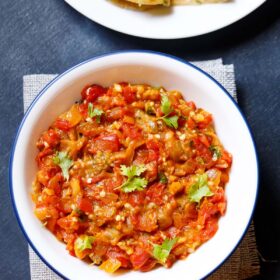
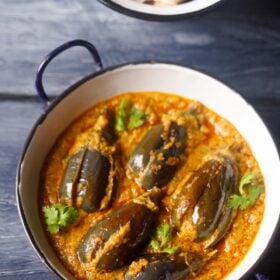
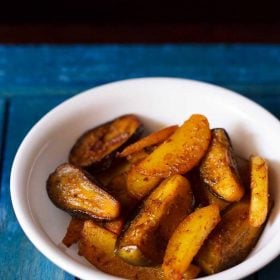
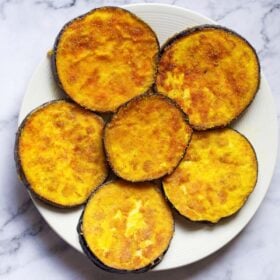








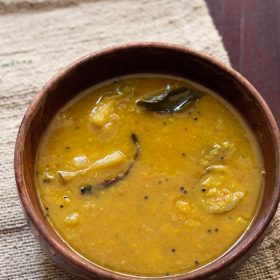
Dassana you are the best!!! Wondering….I’ve been using Indican brand Toor Dal (Canada) – but it never cooks to a mushy paste as it should. I have to pressure cook Toor Dal separately for 20 minutes to get it to the proper consistency. Toor Dal is not supposed to take that long to soften. What brand do you use? This recipe is superb, but I would appreciate if you could give me the brand Toor dal you use!
Love your recipes immensely!!!
Thanks Annu. I use organic 24 mantra brand. use the fresh stock. but organic pulses usually take longer time to cook. try soaking the dal for 30 minutes.
I tried this and was a super hit. Amma told it tastes like authentic wedding sambar.
Thanks Meghana for giving this awesome feedback.
Hi Dassana,
Thank you for this recipe. I have tried veg manchurian gravy style, raw banana curry and a lots more. All of them are very well made and even for a non – cook, its easy to understand picture by picture. I have been cooking vegeterian for almost 14 years now and have few recipes like Aloo Idli, Masala Kadlehittu (Masala Besan Flour Mix) etc that I have made. Would you want to try them too?
I also have the app downloaded, so that in case of any new recipe being tried, I make sure the ingredients do not get missed out at all, else I would end up getting a different taste. If its good, well, I am spared, else …. FIRED 😀
Thanks again!
PS – I cant rate any recipe on any of the pages.
thanks sri for the feedback on the recipes you have tried so far. nice to know about your cooking expertise in vegetarian cuisine. you can share the recipes. i will give a try.
rating is working on the desktop. i will check about the rating issue in the app. thanks for letting me know.
Hi Dassana,
I shall send the recipe in sometime. Please help me out with the email address so that I could send out the snaps taken in a zip format and send it across with the steps taken to make the recipe.
The rating is not working on the desktop. App on the mobile does not have any option to give feed back, write comment, nothing. We can just use it to search the recipe and that’s it.
fine sri. right now i am not sharing pics on the fb page. so for pics let it be. recipes you can share in the comment section, whenever you have time.
rating is working on the desktops. i will still check. about the app also i will check.
thank you for the brinjal sambar. As I am single now, the quantity I cooked (following your instruction,) became more. anyway, it was nice to eat with rice.
thanks for the feedback king. the quantity is for 4 people. next time you can reduce the recipe by half.
This is a very versatile recipe. I used a bunch of vegetables (potato, squash, tomato, green bean) instead of brinjal. I made it without pressure cooker (cooking vegetables in a separate pot, then combining). It still turned out great. I like that the only oil is in the tempering at the end.
One question about the tamarind. How brown/sour is sambar supposed to be? I added 1 teaspoon of tamarind concentrate (not the pulp) and it turned out browner than your photo above. I actually liked the flavor more before I added it.
thank you. sambar is one such recipe where various veggies can be used or even can be made with just one veggies. the browness varies with color of the tamarind paste/concentrate and the color of sambar powder. usually it is more yellowish than brownish. i think the tamarind got too much. concentrate is more thicker than the pulp made with dried tamarind. i would suggest to add first 1/4 tsp. check the sourness and add more 1/4 tsp if you feel its less. the sourness of sambar is not pronounced or hitting the palate, but yes you do feel the sourness when you taste sambar which balances with the additional flavors in the sambar.
Thanks for posting this recipe dassana. I tried sambar for first time and it really came out well. All your recipes are really superb . A big motivation for begginer like me in cooking 😉
welcome kaavya. thanks for motivating me with this feedback. it matters to me.
Hi there, I love your blog! I am just wondering what oil you use for tempering? Thanks!
depends on the dish – sometimes i use coconut oil, sometimes peanut oil and sometimes sunflower or rice bran oil.
What to do with the Tomato? You haven’t mentioned it !!!
the tomato is added when brinjals are added. thanks. i will update in the post.
i love the flavour of kathirikai in sambar. my mom uses the small baby brinjal and adds it just by slicing into it and not chopping. i am too lazy to go hunting for that so use whatever variety i can get
Hi Dassana,
I am a new blogger. I came across ur blog when I was searching Garlic bread… Nice Blog to look around…
Nice recipe too….We make it with moong dhal…
thanks divya.
I love Kathrikai sambar as well perfect with some potato roast on the side 🙂
how can i make sambar powder at home… will be a great help.. thanks
its very easy to make sambar powder. i know the method, but right now i don’t have the proportions of the spices, since i have to make the powder first. i won’t give you some rough or approx measurements as there should be a balance in the overall power. before i post the sambar powder recipe, you can google and you will get sambar powder recipes online.
My favorite sambar of all, we make differently though 🙂 Now I am feeling hungry!